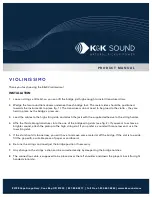
Introduction
www.megger.com
DLRO2 and DLRO2X
8
1.4 Applications
The DLRO2 range measures low resistance values in applications ranging from railways and aircraft to resistance of
components in industry. Any metallic joint can be measured but users must be aware of measurement limitations
depending on application. For example, if a cable manufacturer plans to make resistive measurements on a thin wire,
a low test current should be selected to prevent heating the wire thereby changing its resistance.
This instrument is suited to measuring thick conductors, bonds and quality of welding.
Measurements on electric motors and generators will be inductive and require the user to understand the inductive
mode and charging process before a correct result is achieved.
Electromagnetic noise induced into the leads can interfere with a reading. A noise icon alerts the user, but does not
prevent a measurement.
The DLRO2X features a noise rejection mode that incorporates the Confidence Meter™ (
rejection mode (DLRO2X) on page 37
). This makes the DLRO2X ideal for testing in high noise applications such as
wind turbines, switch yards, and heavy industrial locations.
When dissimilar metals are joined a galvanic effect is created. Users should select a bidirectional mode to make sure
this effect is cancelled. The instrument measures with current flowing in both directions and averages the result.
Aviation – Lightning protection testing measuring mΩ resistance between receptors. Wing tip to wing tip etc.,
using long test leads. Optional long cable reel test leads are available, can be used for assembly of components,
interconnection of equipment, repair and maintenance.
Wind turbines – Lightning protection, measuring mΩ resistance between wing tip to ground connection at base
using long test leads. Optional long cable reel test leads are available.
Rail – Tram and Underground - rolling stock and infrastructure, track high current joints, signalling systems.
Marine - Power wiring systems, protection systems, ship to shore bonding, cathode protection system testing.
Cable laying applications.
Oil and gas pipelines - Bonding between welded joints, grounding systems.
Automotive and EV - Battery connections, weld quality, quality of crimped connections,
assembly robot welding cables.
Cable manufacturers - Quality control, cable length.
Component manufacturers - Quality control.
Space exploration and engineering - structural metal to metal, ground network metal to metal, carbon fibre to
metal, carbon fibre to carbon fibre.
Data Centres - During electrical installation of main panel, generator and UPS systems. Verification of protective
device contact resistance, busbar parallel feeds, busbar lapped joints, optimum resistance over torque and cable
lug to busbar connections. During maintenance using trending data for all aspects of the above, verification after
repair.
Medical hand held opportunity - earthing and bonding systems for protection against microshock and
macroshock.
Panel / Switchgear Manufacturers - End of production line testing, site commissioning, maintenance and fault
finding.
Robotics - Wiring systems and connections which are subject to stress / movement / vibration, bonding of
component parts to minimise static, grounding of machine, welding leads of robot spot welder.
Electrical infrastructure - Cable resistance from one end, cable length, identification of parallel supplies while
connected, cable to lug to connection fault finding, checking assembled connections main supply cables and
panels, switch gear and protective devices, ups and changeover panels, interlinking busbars, interlinking cables,
distribution and PDU boards, lightning protection systems, final circuits.









































